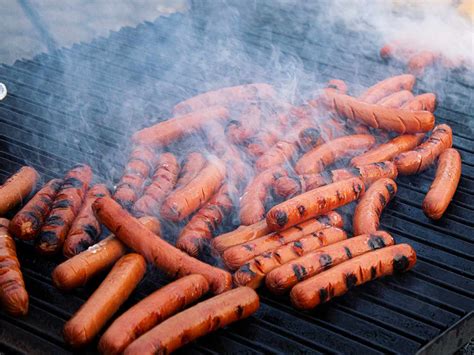
A grilling enthusiast’s simple yet effective hot dog preparation method, learned from his father-in-law, is gaining viral attention for its ability to enhance flavor and texture. The technique involves creating shallow diagonal cuts across the hot dog before grilling, resulting in a perfectly cooked, caramelized dog that holds toppings securely.
Forget everything you thought you knew about grilling hot dogs. A home cook has revealed a game-changing method passed down from his father-in-law that promises to elevate your backyard barbecue game. This isn’t about fancy sauces or obscure ingredients; it’s about a simple technique that maximizes flavor and texture. The secret? Shallow, diagonal cuts across the hot dog before it hits the grill.
The grilling aficionado, who shared the tip on social media, explained that these cuts serve multiple purposes. First, they prevent the hot dog from plumping and splitting, ensuring a more even cook. Second, they create more surface area for caramelization, resulting in a richer, more flavorful bite. Finally, the cuts form small pockets that cradle toppings, preventing them from sliding off with every bite.
“I learned this from my father-in-law,” the cook explained. “He’s been grilling hot dogs this way for years, and they always come out perfect. I was skeptical at first, but after trying it myself, I was hooked.”
The technique is remarkably simple. Before grilling, use a sharp knife to make shallow, diagonal cuts across the hot dog, spacing them about half an inch apart. Repeat on the opposite side, creating a crisscross pattern. The key is to avoid cutting too deeply; the cuts should only penetrate the surface of the hot dog.
Once the hot dogs are scored, they can be grilled as usual. The cuts will expand as the hot dog cooks, creating a visually appealing pattern and allowing the heat to penetrate more evenly. The result is a perfectly cooked hot dog with a crispy exterior and a juicy interior, ready to be topped with your favorite condiments.
The social media post detailing the method has garnered widespread attention, with many users praising the simplicity and effectiveness of the technique. Some have even shared their own variations, such as using different types of knives or experimenting with different spacing between the cuts.
One user commented, “I’ve been grilling hot dogs for years, and I’ve never thought to do this. I tried it last night, and it was a game-changer!” Another added, “This is genius! My hot dogs always split and the toppings always fall off. I can’t wait to try this.”
The father-in-law’s hot dog trick is a testament to the power of simple techniques. It requires no special equipment or ingredients, yet it delivers a significant improvement in flavor and texture. So, the next time you fire up the grill, give this method a try. You might just discover your new favorite way to cook hot dogs.
The Science Behind the Sizzle: Why This Technique Works
While the technique appears deceptively simple, there’s a science behind why scoring hot dogs works so effectively. Understanding the underlying principles can further enhance your grilling expertise and help you fine-tune the method to your preferences.
- Preventing the Burst: Hot dogs, like any encased meat, contain moisture. When heated rapidly, this moisture turns to steam, expanding and creating pressure within the casing. Without a way to release this pressure, the casing can burst, resulting in a split and often misshapen hot dog. The shallow cuts act as escape routes for the steam, preventing pressure buildup and ensuring the hot dog retains its shape.
- Maximizing Caramelization (The Maillard Reaction): Caramelization is a browning reaction that occurs when sugars are heated. In the context of grilling, it’s responsible for the delicious, slightly sweet, and complex flavors we associate with perfectly grilled food. The Maillard reaction, a related chemical process, also contributes significantly to flavor development. By scoring the hot dog, you dramatically increase the surface area exposed to direct heat. This increased surface area translates to more opportunities for caramelization and Maillard reaction to occur, resulting in a richer, deeper flavor profile.
- Enhanced Heat Distribution: The cuts also facilitate more even heat distribution throughout the hot dog. Without the cuts, the heat primarily cooks the surface, while the interior may take longer to reach the desired temperature. The cuts allow the heat to penetrate deeper and faster, ensuring that the entire hot dog is cooked evenly, preventing a burnt exterior and a cold interior.
- Topping Security: The small pockets created by the crisscross pattern aren’t just aesthetically pleasing; they’re also functional. They act as tiny reservoirs that hold toppings in place, preventing them from sliding off with every bite. This is especially useful for toppings like chili, cheese, or sauerkraut, which tend to be particularly prone to slippage.
Beyond the Basic Score: Variations and Experimentation
While the basic technique is effective, there’s plenty of room for experimentation and customization. Here are some variations to try:
- Different Scoring Patterns: Instead of a simple crisscross pattern, try experimenting with different patterns. For example, you could try making a series of parallel cuts on each side, or even creating a diamond pattern. The pattern you choose will affect the appearance of the hot dog and may also have a subtle impact on the flavor and texture.
- Varying the Depth of the Cuts: The depth of the cuts is another factor that can be adjusted. Shallower cuts will primarily affect the surface of the hot dog, while deeper cuts will allow the heat to penetrate more quickly. Be careful not to cut too deeply, as this could cause the hot dog to fall apart.
- Using Different Types of Knives: The type of knife you use can also affect the outcome. A sharp, thin-bladed knife will make cleaner, more precise cuts, while a duller knife may tear the hot dog. A paring knife or a utility knife is generally a good choice.
- Experimenting with Different Hot Dog Varieties: The technique works well with most types of hot dogs, but you may find that it’s particularly effective with certain varieties. For example, all-beef hot dogs tend to be more prone to splitting, so scoring them can be especially helpful.
- Adding Marinades: Before grilling, consider marinating the scored hot dogs in your favorite marinade. The cuts will allow the marinade to penetrate deeper into the hot dog, infusing it with even more flavor.
- Pre-Grilling Preparation: Some chefs suggest slightly scoring the hot dogs while still cold, making the process easier and preventing the hot dog from squishing under pressure. This also helps the cuts remain cleaner and more defined.
The Importance of Hot Dog Quality: Start with the Best
While the scoring technique can improve the grilling experience for any hot dog, the quality of the hot dog itself remains paramount. Starting with a high-quality hot dog will yield the best possible results.
- All-Beef vs. Mixed Meat: All-beef hot dogs are generally considered to be of higher quality than those made with a mixture of meats. They tend to have a richer, more robust flavor and a more satisfying texture.
- Natural Casing vs. Skinless: Hot dogs with natural casings have a distinctive “snap” when you bite into them. Skinless hot dogs, on the other hand, tend to be softer and more uniform in texture.
- Sodium Content: Be mindful of the sodium content, especially if you are sodium-sensitive. Look for lower-sodium options without compromising on flavor.
- Read the Ingredients: Scrutinize the ingredient list. Opt for hot dogs with fewer artificial additives, preservatives, and fillers. High-quality hot dogs typically have a shorter, more recognizable ingredient list.
- Consider Local Butchers: Explore options from local butchers or artisanal meat producers. These sources often offer unique hot dog varieties with superior flavor and quality.
Grilling Techniques for Scored Hot Dogs: Mastering the Heat
Even with the scoring technique, proper grilling technique is crucial for achieving the perfect hot dog.
- Preheating the Grill: Ensure your grill is properly preheated before adding the hot dogs. This will help to sear the surface quickly and prevent sticking.
- Medium Heat: Grill the hot dogs over medium heat to prevent them from burning. High heat can cause the casings to char before the interior is fully cooked.
- Even Cooking: Rotate the hot dogs frequently to ensure even cooking on all sides.
- Doneness: Use a meat thermometer to check the internal temperature of the hot dogs. They should reach an internal temperature of 160°F (71°C) for optimal safety and flavor.
- Indirect Heat: If your grill has different heat zones, consider moving the hot dogs to a cooler zone after searing them to finish cooking through without burning.
- Avoid Overcrowding: Don’t overcrowd the grill. Give the hot dogs enough space so the heat can circulate evenly.
- Clean Grill Grates: Always start with clean grill grates. This prevents sticking and ensures even heat distribution. Use a grill brush to remove any residue from previous grilling sessions.
- Using a Grill Basket: For smaller hot dogs or cocktail wieners, consider using a grill basket to prevent them from falling through the grates. This is especially useful if you’re grilling over charcoal.
- Charcoal vs. Gas: The type of grill you use (charcoal or gas) can affect the flavor of the hot dogs. Charcoal grills tend to impart a smoky flavor, while gas grills provide more consistent heat.
- Adding Wood Chips: If you’re using a gas grill and want to add a smoky flavor, consider using a smoker box filled with wood chips.
Toppings That Complement the Technique: Elevating the Experience
The scored hot dog provides an excellent base for a wide variety of toppings. Here are some ideas to elevate your hot dog experience:
- Classic Condiments: Mustard, ketchup, relish, and onions are classic toppings for a reason. They provide a balance of sweet, tangy, and savory flavors.
- Chili and Cheese: A hearty chili and melted cheese is a crowd-pleasing combination.
- Sauerkraut and Mustard: This tangy combination is a popular choice, especially in the Northeast.
- Chicago-Style: This iconic hot dog is topped with yellow mustard, chopped white onions, bright green sweet pickle relish, a dill pickle spear, tomato slices or wedges, pickled sport peppers, and a dash of celery salt.
- Coleslaw: Creamy coleslaw adds a cool and crunchy element to the hot dog.
- Spicy Options: Jalapeños, sriracha, or chili flakes can add a kick of heat.
- Gourmet Options: Experiment with gourmet toppings like caramelized onions, roasted red peppers, or truffle aioli.
- Bacon-Wrapped: Wrap the hot dog in bacon before grilling for an extra layer of flavor and texture.
- Mac and Cheese: Top your hot dog with creamy mac and cheese for a truly indulgent treat.
- Mediterranean Flavors: Combine hummus, feta cheese, and chopped cucumbers for a Mediterranean-inspired hot dog.
The Cultural Significance of Hot Dogs: A Culinary Icon
Hot dogs are more than just a food; they are a cultural icon, deeply embedded in American history and tradition. From baseball games to backyard barbecues, hot dogs have been a staple of American cuisine for over a century.
- Origins: The exact origins of the hot dog are debated, but it is believed to have originated in Germany in the 15th century. German immigrants brought the sausage to America in the 19th century.
- Early Popularity: Hot dogs gained popularity in the United States in the late 19th century, particularly at baseball games. Vendors sold them from carts outside the stadiums, and they quickly became a fan favorite.
- The Nathan’s Famous Hot Dog Eating Contest: This annual event, held on July 4th at Coney Island, New York, is a testament to the enduring popularity of hot dogs.
- Regional Variations: Hot dogs come in a wide variety of regional variations, each with its own unique toppings and flavors.
- Hot Dogs in Pop Culture: Hot dogs have been featured in countless movies, television shows, and songs, solidifying their place in American pop culture.
- Hot Dog Etiquette: While there are no hard and fast rules about eating hot dogs, there are some generally accepted guidelines. For example, it is generally considered acceptable to eat a hot dog with your hands, but using a knife and fork is frowned upon.
- Beyond America: While synonymous with American cuisine, variations of the hot dog exist worldwide, adapted to local tastes and ingredients.
Health Considerations: Enjoying Hot Dogs in Moderation
While hot dogs are a delicious treat, it’s important to consume them in moderation as part of a balanced diet.
- Sodium Content: Hot dogs can be high in sodium, which can contribute to high blood pressure. Look for lower-sodium options.
- Processed Meats: Hot dogs are processed meats, which have been linked to an increased risk of certain types of cancer.
- Fat Content: Hot dogs can be high in fat, particularly saturated fat. Choose leaner varieties.
- Additives and Preservatives: Be mindful of the additives and preservatives in hot dogs. Opt for brands with fewer artificial ingredients.
- Portion Control: Practice portion control to limit your intake of calories, sodium, and fat.
- Balance with Healthy Sides: Pair your hot dog with healthy sides like grilled vegetables, a salad, or fruit.
- Preparation Methods: Grilling, baking, or broiling hot dogs are healthier alternatives to deep-frying.
- Consult with a Nutritionist: If you have specific health concerns, consult with a registered dietitian or nutritionist for personalized dietary advice.
FAQ: Your Burning Hot Dog Questions Answered
- Why does scoring hot dogs work? Scoring hot dogs prevents them from splitting, increases surface area for caramelization, and creates pockets for toppings, enhancing flavor and texture. The cuts act as escape routes for steam, preventing pressure buildup within the casing.
- How deep should I cut the hot dogs? The cuts should be shallow, penetrating only the surface of the hot dog. Avoid cutting too deeply, as this could cause the hot dog to fall apart.
- What kind of knife should I use? A sharp, thin-bladed knife, such as a paring knife or utility knife, is ideal for making clean, precise cuts.
- Can I use this technique with any type of hot dog? Yes, the technique works well with most types of hot dogs, including all-beef, pork, and chicken varieties. However, it may be particularly beneficial for all-beef hot dogs, which tend to be more prone to splitting.
- What are some good toppings to use with scored hot dogs? Classic toppings like mustard, ketchup, and relish work well, but you can also experiment with chili, cheese, sauerkraut, coleslaw, or gourmet options like caramelized onions or truffle aioli. The pockets created by the scoring technique will help to hold the toppings in place.
The viral hot dog grilling tip, popularized by a father-in-law’s time-tested method, offers a simple yet impactful way to transform ordinary hot dogs into culinary delights. By understanding the science behind the technique, experimenting with variations, and focusing on the quality of ingredients, grill masters can achieve hot dog perfection and impress their guests with a truly memorable barbecue experience. The combination of enhanced flavor, improved texture, and better topping adherence makes this method a must-try for any grilling enthusiast. So, fire up the grill, grab your sharpest knife, and get ready to elevate your hot dog game to a whole new level. Enjoy!









